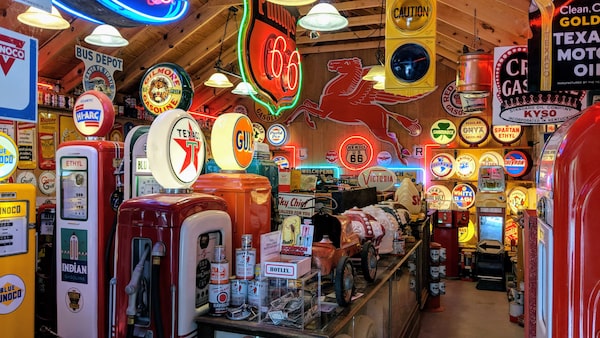
Johnnie Meier, proprietor of the Classical Gas Museum in New Mexico.Peter Nowak
Johnnie Meier flashes a knowing grin when asked what the oldest item at his Classical Gas Museum is before he dashes inside to procure it.
“Here it is,” he says, proudly brandishing a yellow oil can with a drawing of a brontosaurus on the label. The caption reads: One million years old.
“This is it – it says so right on the can!” he says, barely suppressing a laugh. “You weren’t expecting that, were you?”
Meier is a whimsical museum proprietor – a fact that’s evident in his jokes, but also in his collection. The Classical Gas Museum, located on State Road 68 in tiny Embudo, New Mexico – halfway between Santa Fe and Taos – is an odd, jumbled assortment of antique road signs, vintage gas pumps, old grease cans and who knows what else.
Scattered around the two-acre property and inside a 1,000-square-foot shack, it’s an eclectic miscellany that holds much appeal to fans of classic cars, Americana and the romantic lure of the open road of a bygone era.

Inside a 1,000-square-foot shack, it’s an eclectic miscellany that holds much appeal to fans of classic cars, Americana and the romantic lure of the open road of a bygone era.Peter Nowak
The Classical Gas Museum started as Meier’s personal collection nearly 30 years ago. Working as a laser scientist at the nearby Los Alamos National Laboratory, the same facility where the atomic bomb was designed in the 1940s, he grew enamoured with vintage gas station signs and pumps.
It wasn’t just a weird fetish, Meier explains, but rather a burgeoning appreciation of pop art.
“These gas pumps are pieces of sculpture. The graphic design is quite remarkable – and it had to be,” he says.
“Oil and gas are commodities. There are a hundred brands of oil. How do you distinguish yourself? It’s the graphics and the packaging. These are outstanding examples of graphic art.”
By the time he took early retirement at 51, his collection had grown unwieldy and needed to be put somewhere.

Marked out front by an old Frontier gas station sign that depicts a man on a bucking horse and a caption that reads 'rarin’ to go,' the place is impossible to miss.
Meier found the ideal property in the town of Embudo – he lives in a house behind the museum – on a highly trafficked road between two tourist hotspots and no zoning laws to deal with. Twenty years ago, the Classical Gas Museum opened to the public.
Marked out front by an old Frontier gas station sign that depicts a man on a bucking horse and a caption that reads “rarin’ to go,” the place is impossible to miss.
The outdoor area is more junkyard than museum, with dozens of pumps in various states of decay or repair. Current, surviving brands such as Shell, Chevron and Phillips 66 stand tall next to faded names such as Dixie Oils, Shamrock and Sinclair.
An assortment of large metal signs – Pennzoil, Amalie Motor Oil, Quaker State – line the edge of the property. Dozens of hubcaps sit carefully arrayed at the rear.
Curiously, not everything is immediately gas- or car-related. A pair of dinosaur models sit amidst the din. Statues of the Blues Brothers greet visitors just beyond the entrance.

Dozens of hubcaps sit carefully arrayed at the rear.
Meier explains that he sometimes can’t help himself when acquiring new pieces. “People call me and say, ‘Come check out my things,’ so I go out there for a gas pump and I come back with all this weird stuff,” he says. “My criteria is: Is it cool?”
Inside is where he keeps his most prized possessions: dozens of old oil and grease cans – including at least one that is apparently a million years old – pristine road signs and posters and painstakingly restored Texaco and Sunoco pumps. Much of it is decades-old, if not a century. All of it is brilliantly illuminated with neon.
Meier estimates he gets about 20 visitors a day during tourist season, with numbers dwindling in the winter. He doesn’t charge admission, but he does accept donations that he then gives to charities. He’s also old school – the Classical Gas Museum doesn’t even have a website.
Local tourists are attracted by the nostalgia, he says, while foreign visitors see the place as symbolic of the American dream.
“What made America great was cheap gas and great roads,” Meier says. “It represents the best things about America: free enterprise, competition, cheap gas.”

Much of it is decades-old, if not a century.
Ironically, given his obvious interest in the past, Meier doesn’t oppose the auto industry’s current move toward electrifying cars. He’s actually in favour of it.
“We’re necessarily going to have to get off petroleum, which makes it all the more necessary to preserve this history,” he says. “There is a transitioning happening, but people will always be driving classic cars, it’s just too much fun.”
That doesn’t mean a Tesla Supercharger is ever likely to be added to the Classical Gas Museum. Meier considers 1980 as the unofficial cutoff year for inclusion in his collection. “That’s when things got boring.”
Shopping for a new car? Check out the new Globe Drive Build and Price Tool to see the latest discounts, rebates and rates on new cars, trucks and SUVs. Click here to get your price.
Sign up for the weekly Drive newsletter, delivered to your inbox for free. Follow us on Instagram, @globedrive.